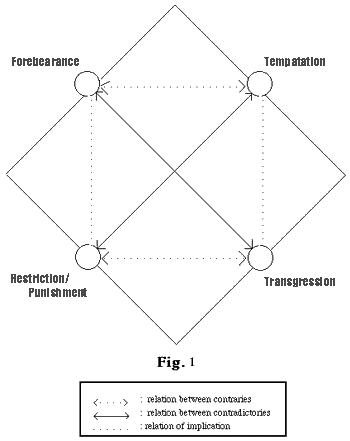
Woodcut to Wie der Würffel auff ist Kumen (Nuremberg: Max Ayrer, 1489). Reprinted in and courtesy of The Complete Woodcuts of Albrecht Dürer, ed. Willi Kurth (New York: Dover, 1963).
The Dürer Woodcut: Narratology
This image is of interest for a number of reasons that exemplify narratology's precepts. For one thing, the image presents an entire narrative sequence as a single pictorial representation, thus illustrating how a story or fabula can be completely re-presented by discourse or sjuzet. The story goes something like this: 1) The first "frame" of the sequence is the right-hand half of the image, in which a travelling knight is stopped by the devil, who holds up a die to tempt the knight to gamble; 2) the second "frame" is the bottom-left-hand corner of the image, where a quarrel breaks out at the gambling table; 3) the third "frame" is the top-left-hand corner of the image, where the knight is punished by death on the wheel. By having the entire sequence in a single two-dimensional space, the image comments on the fact that narrative, unlike life, is never a gamble but always stacks the deck towards some fulfilling structural closure. (A similar statement is made in the Star Trek episode I analyze under Lesson Plans.) Here, the structural relationship between temptation and punishment is underlined by the fact that the two actions are juxtaposed on the top-right and top-left hand of the image. Temporal action is thus re-presented as a spatial juxtaposition, suggesting that there is a deeper oppositional logic to what might otherwise appear to be merely a series of cause-and-effect actions.
The structural nature of the implied juxtapositions in the woodcut thus could be said to underline Algirdas Greimas' point that narratives subscribe to foundational "deep structures," which are organized by way of oppositions. The Greimassian square for this wordless narrative could be said to be as follows (Fig. 1):
In this semiotic square, "restriction/punishment" takes the place of "non-temptation," while "transgression" takes the place of "non-forbearance," following the tendency of the contradictory term to be more than the term to which it is associated by a "relation of implication." (For an explanation of the workings of the Greimassian square, see the Greimas module on the semiotic square.)
By having the woodcut narrative proceed from the right-hand to the top left, the image also could be said to be going backward since the same story written in text form would have us reading from top left to bottom right, much as you are now reading this explication. The image's backward movement could be said to exemplify Peter Brooks' Freudian interpretation of narrative: the irritation of plot (temptation, desire for gratification) competes against the desire to return to the quiescence of narrative closure, which is here tied literally to the death drive by having the subject of the action die at the end of the sequence. The English language even allows us to sum up what Brooks sees as the opposing forces of narrative into a single word-play, die/die, or the unordered gamble that is life and the structured fact of narrative, which is usually bounded by death (our primary metaphor for closure).
For other applications, click the following links:
Proper Citation of this Page:
Felluga, Dino. "The Dürer Woodcut: Narratology." Introductory Guide to Critical Theory.[date of last update, which you can find on the home page]. Purdue U. [date you accessed the site]. <http://www.purdue.edu/guidetotheory/narratology/narrativeimage/>.


